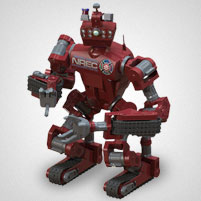CHIMP to the Rescue

What's part ape, part tank and 100 percent innovative? Carnegie Mellon University's CHIMP — the CMU Highly Intelligent Mobile Platform robot.
A team from CMU's National Robotics Engineering Center (NREC) is in the process of building CHIMP to compete in a $2 million U.S. Defense Department prize competition — the Defense Advance Research Projects Agency's (DARPA) Robotics Challenge.
CHIMP is a human-sized robot that, like a real chimpanzee, can grasp objects with ‘hands' that include opposable thumbs. Like a tank, it moves via tracks positioned on its limbs, generally using all four for stability but able to move on just two when necessary.
"We selected a design with a near human form so that the robot would be able to operate in environments engineered for humans," explained Tony Stentz, NREC director, team leader and Robotics Institute research professor, in describing CHIMP's unique form.
"Rather than design a machine that would need to balance itself as it carefully steps over debris, we are building a robot that is able to drop down on rubber tracks and roll over debris," he added. It's a distinct advantage.
DARPA is sponsoring the challenge with the goal of developing robotic technologies for disaster response — as in the 2011 Fukushima nuclear plant incident — where humans can't safely get close enough to contain the threat. Such robots would need to execute human-like complex tasks while navigating environments meant for people.
In fact, to win the challenge, a robot will have to complete a number of tasks, including climbing a ladder, driving a vehicle and operating a power tool.
CHIMP is designed to operate with supervised autonomy, meaning a remote human operator selects its tasks, and the robot performs the actions while moving safely.
"This enables CHIMP to be highly capable without the complexity associated with a fully autonomous robot," said Stentz. "This type of robot has tremendous potential."
Stentz, who earned his masters and Ph.D. in computer science at CMU, came to the university "because it has the best computer science doctoral program in the world."
"I stayed on," he added, "because it has the best robotics institute in the world."
Stentz's team — dubbed Tartan Rescue — was selected as one of seven to compete in Track A, the competition segment, in which teams develop both hardware and software. Another CMU team, headed by Christopher Atkeson, professor of robotics and human-computer interaction, was selected for Track B, in which teams develop software for a virtual competition.
NREC was also a key participant in DARPA's 2007 Urban Challenge competition, in which the CMU team, Tartan Racing, took first prize. The CMU team took second and third place in the 2005 challenge.
"CMU is a great place for building robots," Stentz noted. "Robots require a broad range of technologies: sensors, mechanisms, user interfaces, simulation, and software for perception, motion planning, and control. CMU has experts in all of these areas and a culture of collaboration."
Related Links: School of Computer Science | Read press release | Robotics Institute | National Robotics Engineering Center | Tartan Rescue | Additional Major in Robotics
